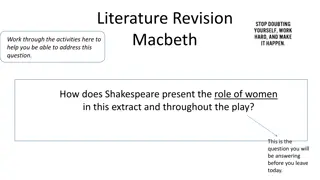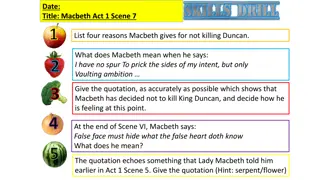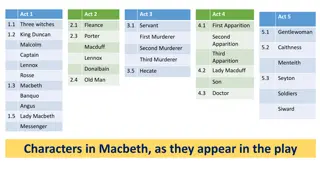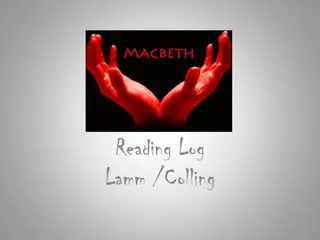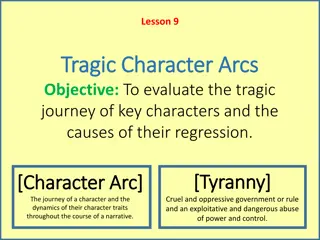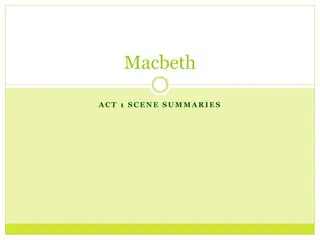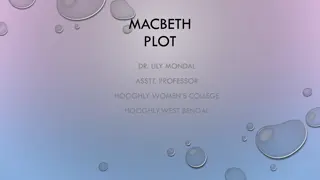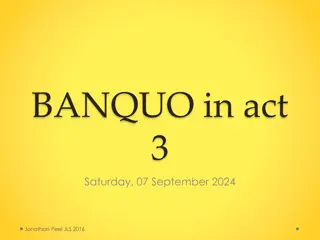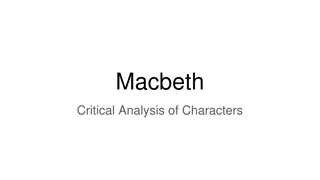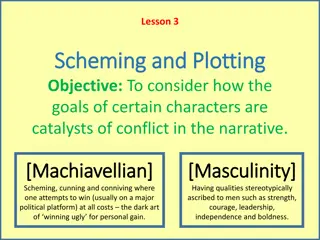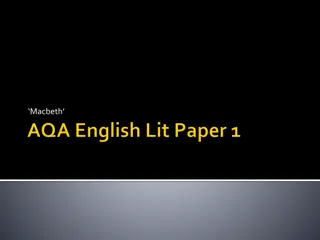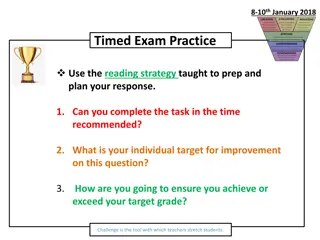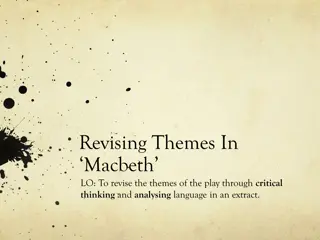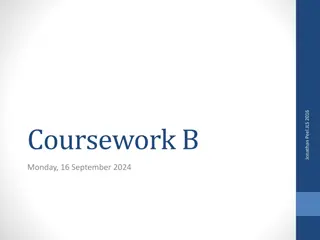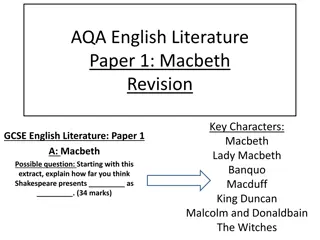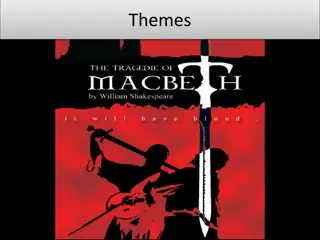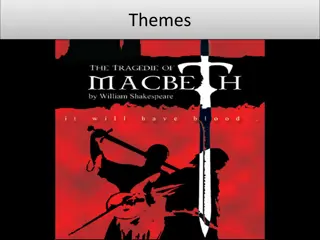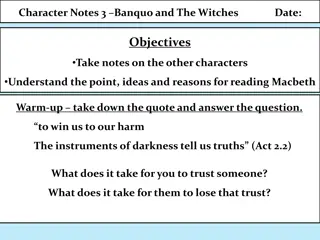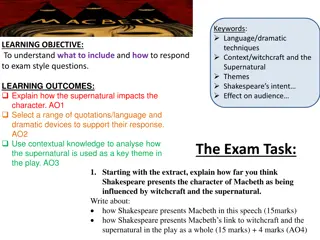Insights into Shakespeare's Tragic Masterpiece Macbeth
Discover the fascinating background of Shakespeare's renowned play Macbeth, including its historical roots, the influence of King James I, and the characteristics that define it as a tragedy. Unveil the protagonists, witches, and the intriguing elements that contribute to the downfall of the tragic hero, Macbeth.
Download Presentation

Please find below an Image/Link to download the presentation.
The content on the website is provided AS IS for your information and personal use only. It may not be sold, licensed, or shared on other websites without obtaining consent from the author.If you encounter any issues during the download, it is possible that the publisher has removed the file from their server.
You are allowed to download the files provided on this website for personal or commercial use, subject to the condition that they are used lawfully. All files are the property of their respective owners.
The content on the website is provided AS IS for your information and personal use only. It may not be sold, licensed, or shared on other websites without obtaining consent from the author.
E N D
Presentation Transcript
Shakespeare- Renaissance Drama Rebirth of interest in Greek Tragedies Shakespeare wrote three types of plays: Histories Comedies- has a happy ending Tragedies- tragic hero comes to a miserable end
Historical Background The Title Character based on a historical Macbeth, king of 11th century Scotland He seized the throne after killing King Duncan
Shakespeares Sponsor King James the First James interested in witchcraft- but didn t necessarily believe- used it for political purposes Belief about witches widespread- WHY:?illiterate people, no scientific explanation
Characteristics of Tragedy Tragic hero must begin the play as a person of importance Someone looked up to because of position and/or ability Cannot be an average guy Never a woman
Characteristics of Tragedy Tragic hero exhibits extraordinary abilities Also has a TRAGIC FLAW that leads to his downfall Tragic flaw is usually associated with HUBRIS- excessive pride Macbeth s tragic flaw is driven by his AMBITION
Characteristics of Tragedy Antagonist- outside forces with whom the hero battles Pushes him toward the tragic ending
Characteristics of Tragedy A series of casually related events lead the hero to the catastrophe Catastrophe- the hero dies, others may die
Characteristics of Tragedy Right before his death tragic hero must recognize his flaw his OOPS moment Gains the pity of the audience- they then feel fear- for if this can happen to a man so great, what does it mean for the common man.
Characteristics of Tragedy Tragic hero comes to an unhappy and miserable end
Characteristics of Tragedy Tragic hero meets death with dignity and courage Macbeth somewhat problematic in the end for some readers Question whether or not his OOPS moment is big enough
Comic Relief in Tragedy The following of a serious scene with a lighter humorous scene Gives audience relief Juxtaposition heightens the prior tragedy
Soliloquy Speech by a character ALONE on stage Shares innermost thoughts Only the audience hears.
Aside Remark from a character to the audience Can also be a remark from one character to another character that other characters on the stage DO NOT hear Will indicate in the text aside to- character name Aside- to audience only
Verse Drama Dialog consists mostly of poetry with a fixed rhyme or meter Blank verse- unrhymed iambic pentameter Shakespeare pulls characters out of verse to indicate something about his or her character
Motif: a recurring object, concept, or structure in a work of literature Blood Sleep Manhood Water Clothing Weather Birds Light and Dark
Shakespeares Language NOT OLD ENGLISH Archaic word usage Grammatical Forms: thou, thee, thy, thine, and thyself instead of you. Outdated Verb forms: Art for are Cometh for comes Fewer helping verbs: Not: Don t you know he has? Unfamiliar vocab: Seeling=blinding Choppy=chapped Use the marginal notes in textbook to help with meaning. He coined words- like assassination
Dramatic Irony What appears to be true characters in the play is seen to be false by the audience The audience has a more complete picture of the action-watches EVERYTHING unfold
Themes Theme: A central idea or unifying generalization implied or stated by the literary work Not a subject Must be in statement form Should NOT be an absolute Can be applied to humans and life beyond the text Macbeth Themes: Things are not always what they seem Ambition is often blinding Power can corrupt those who have it. Superstition often affects human behavior
Key Characters Duncan Malcolm Donnalbain Macbeth Lady Macbeth Banquo Fleance Macduff Lady Macduff and her son Witches Porter Old Man Three murderers Gentlewoman Seyton Siward and Young Siward Ross and Lennox
Setting and Places 11thcentury Medieval Scotland Brief section in England with King Edward the Confessor Macbeth s Castle: Inverness on Dunsinane Hill Macduff s Castle: Fife BirnamWoods- a forest Scone-where kings are crowned Instead: know you not he has? Unusual word order; Verbs before subjects Objects before verbs Says: O, never shall that sun that morrow see! instead of O, the sun shall never see that morrow!
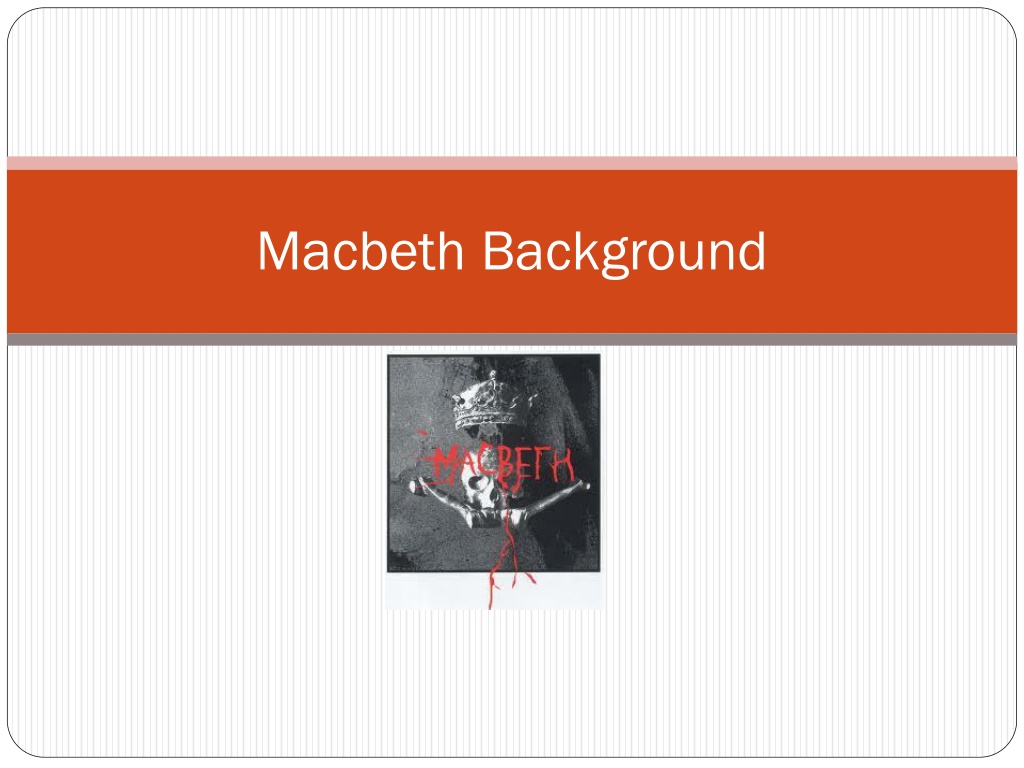
 undefined
undefined











